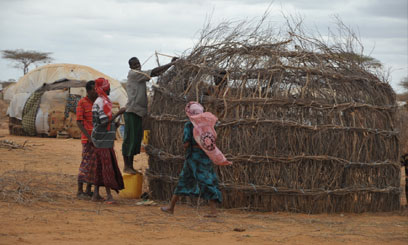NAIROBI, Kenya, Jul 14 – There seems to be no immediate solution to the current crisis at the Dadaab refugee camp with the continued arrivals hitting an all time high of 1,400 immigrants a day.
The world’s largest refugee camp, located in Northern Kenya, is already holding five times more than its intended capacity of 90,000 people.
The Permanent Secretary at the Ministry of Internal Security Francis Kimemia has urged the international community to establish camps within Somalia to help stop the inflow of Somali nationals who are fleeing the current drought situation.
Mr Kimemia said there was no need to open up another camp in Kenya.
He instead urged the international community to engage the African Union Mission in Somalia (AMISOM) to establish a safe zone near the Kenyan border with Somalia for the provision of relief supplies.
“Instead of urging us to extend camps within Kenya, isn’t it possible to start camps inside Somalia just close to the border with Kenya then we get the AMISOM to secure the places and Somalis can be settled there?” he wondered, pointing out that the influx of refugees was posing a great security risk to the country.
UK based aid agency Oxfam has however called on the government to urgently open up the uninhabited Ifo II camp to deal with the current influx of refugees from Somalia, who are running away for the biting hunger in their country.
Speaking to capital news, Oxfam’s acting Country Director Joost Van de Lest said that there was urgent need to deal with the current situation of 1,400 daily arrivals of refugees.
“Setting up a new camp will take a lot of time when we need an urgent solution; there must be a solution in the short term to accommodate these refugees in the empty camp,” he said adding that the camp is well equipped with water and sanitation facilities.
Mr Joost called for urgent response to the plight of other Kenyans who are equally hard hit by drought.
“Much attention has been given to Dadaab because people are coming in but in Wajir for instance, the rate of malnutrition is up to forty percent; the situation is steadily declining and may get worse since we do not expect rains soon,” he added.
Oxfam’s regional communications director for East Africa Alun McDonald has also warned that that if the refugees are not settled, tensions may rise as they compete for resources with the locals.
“The larger challenge is in the failure to settle the refugees because they will not be in any designated area.
“They are using land and resources of people who are already poor and have been affected by the drought. There is a risk of increasing the tension between the arriving refugees and the local Kenyan community,” he warned
Oxfam has also expressed fear of an outbreak of diseases at the temporary unequipped camps where 60,000 new arrivals are sheltering in tents outside the camp boundaries, with limited access to clean water and sanitation facilities.
A meeting on Thursday between the Prime Minister and officers of the United Nations in Dadaab was expected to provide more headway in dealing with the situation.
Further, the arrival of UNICEF’s Executive Director Anthony Lake in Nairobi is expected to strengthen the concerted response by UN agencies and partners to the humanitarian crisis, which is threatening to engulf millions of people, many of whom are children.
An estimated 10 million people are in need of humanitarian aid in the horn of Africa region. Almost 500,000 children in Somalia, Ethiopia and Kenya are suffering from imminent, life-threatening severe malnutrition. In addition, over 1.6 million children under the age of five are acutely malnourished.










































